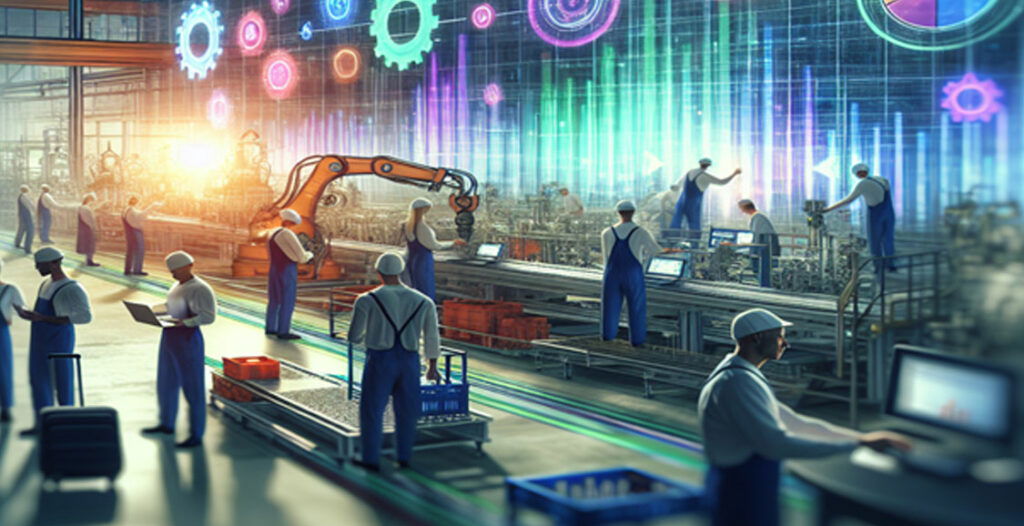As you navigate today’s manufacturing landscape, you find yourself at the intersection of three revolutionary technologies: artificial intelligence (AI), the Internet of Things (IoT), and advanced data analytics. These innovations work in concert to propel Industry 4.0, enabling intelligent automation, predictive maintenance, and operational excellence.
In this article, you will explore the convergence of AI, IoT, and data analytics within smart factories. Learn how these technologies synergize to optimize production, reduce downtime, enhance agility, and drive data-driven decision-making. Discover real-world use cases, implementation challenges, and the outlook for leveraging AI, IoT, and analytics on the Industry 4.0 journey.
The Convergence of AI, IoT, and Big Data Analytics in Industry 4.0
AI Enables Intelligent Automation
Artificial intelligence powers intelligent automation in Industry 4.0. AI technologies like machine learning and deep learning analyze vast amounts of data to detect patterns, learn independently, and make predictions or recommendations with minimal human input. Manufacturers can leverage AI to automate tasks like predictive maintenance, process optimization, and quality assurance.
IoT Generates Data for Analytics
The Internet of Things refers to the network of connected sensors, devices, and machines that generate data in manufacturing environments. IoT devices track assets, monitor equipment and processes, and enable real-time visibility into operations. The data from IoT sensors and systems feeds into analytics platforms.
Advanced Analytics Drive Insights
Big data analytics examines the huge volumes of data from connected systems to uncover insights that drive efficiencies. Predictive analytics can forecast outcomes and trends to enable proactive decision-making. Prescriptive analytics goes a step further by recommending optimal courses of action. Analytics paired with AI and IoT paves the way for intelligent, data-driven operations.
Synergies Enable Next-Level Automation
Individually, AI, IoT, and data analytics offer significant benefits for manufacturers. However, the convergence of these technologies unlocks transformative capabilities for Industry 4.0. AI can tap into rich data streams from IoT to continuously learn and optimize systems. Analytics provides insights to fuel AI and automate processes. Together, these technologies power intelligent automation, predictive maintenance, and end-to-end operational visibility for the factory of the future.
Real-World Applications: Predictive Maintenance, Supply Chain Optimization, and More
- Predictive maintenance: The convergence of AI, IoT, and data analytics enables predictive maintenance, allowing manufacturers to anticipate equipment failures before they occur. By analyzing sensor data from IoT devices, AI systems can detect anomalous behavior patterns that signal impending breakdowns. Manufacturers can then perform maintenance proactively, reducing costly unplanned downtime.
- Optimized supply chain management: AI, IoT, and data analytics synergize to optimize supply chain operations. IoT sensors provide real-time data on inventory levels, equipment status, and environmental conditions. AI algorithms analyze this data to gain insights into usage trends, inefficiencies, and risks. Manufacturers can then make data-driven decisions to improve forecasting, streamline logistics, minimize waste, and hedge against disruptions.
- Automated quality control: Computer vision AI leverages data from cameras and sensors to automatically inspect components and finished goods. The AI learns what constitutes a high-quality, defect-free product and can spot imperfections with superhuman speed and precision. This reduces the need for manual quality control, boosting productivity and ensuring consistent standards.
By uniting AI, IoT, and data analytics, manufacturers can achieve new heights of operational excellence, agility, and customer value. These technologies usher in an era of intelligent, connected production where automation, optimization, and data-driven decision-making reign supreme.
Challenges and Best Practices for Implementation
Several challenges can arise as manufacturers work to integrate AI, IoT, and data analytics within their operations. Following certain best practices is critical to overcoming these obstacles and ensuring successful implementation.
- Lack of data standardization: The data collected from various sensor networks and enterprise systems often lacks consistency, making it difficult to aggregate and analyze. To address this, manufacturers should establish data governance policies to standardize data collection and formatting across systems.
- Security concerns: Networking industrial equipment and accessing operational data remotely poses cybersecurity risks. Manufacturers must implement strong security measures like data encryption, user authentication, and network segmentation to protect connected systems and sensitive data.
- Legacy technology constraints: Many manufacturers have invested heavily in legacy equipment and software over decades, and retrofitting or replacing these systems to enable connectivity can be cost-prohibitive. When possible, manufacturers should choose interoperable technologies and open architectures to integrate new and existing systems. They can also deploy IoT gateways to connect legacy equipment to the network.
- Change management challenges: Implementing advanced technologies often requires new skills, business processes, and even organizational structures. Manufacturers must provide employees with continuous training in new systems and nurture a culture that embraces constant change and innovation. Starting with small pilot projects can help organizations adapt incrementally.
Following these best practices around data standardization, security, legacy technology integration, and change management will help manufacturers navigate the challenges of implementing Industry 4.0 technologies. While the road ahead may not always be easy, the rewards of increased operational efficiency, productivity, and competitiveness will make the journey worthwhile.
Conclusion
You now understand how AI, IoT, and data analytics intersect to enable Industry 4.0. By implementing these synergistic technologies, manufacturers can achieve new heights of efficiency, productivity, and innovation. However, succeeding with Industry 4.0 requires executive buy-in, strategic IT investments, cultural change management, and cross-functional collaboration. Approach this digital transformation as a journey, not a destination. Start with pilot projects, learn from iterations, and scale successes. With the right strategy and execution, these exponentially powerful technologies can help manufacturers optimize operations, empower employees, and create customer value.
Stay ahead in Industry 4.0 with exclusive insights and expert advice on AI, IoT, and data analytics. Subscribe to my LinkedIn newsletter for strategies on securing executive buy-in, making strategic IT investments, and fostering cross-functional collaboration. Join us on the journey to optimize operations, empower employees, and create lasting customer value. Subscribe now for the latest in manufacturing innovation.













